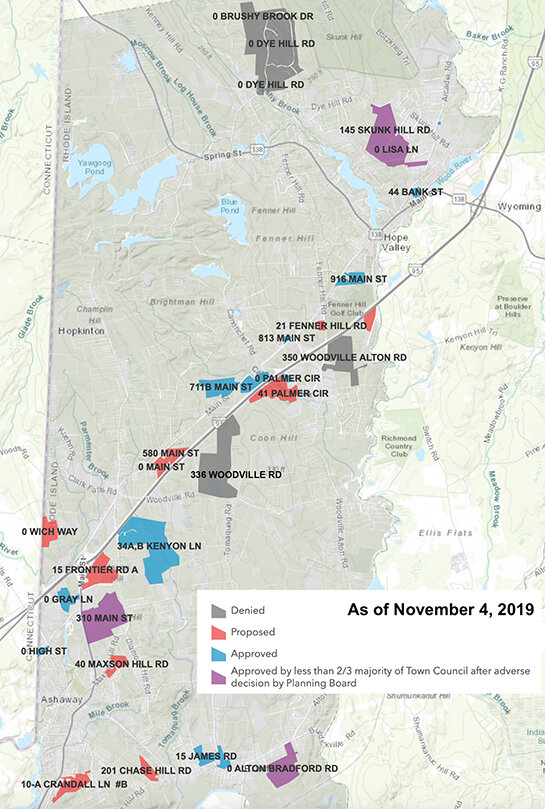Hopkinton Solar Development Gets Mapped Out
December 14, 2019

HOPKINTON, R.I. — The controversial issue of developing utility-scale solar and wind on open space has divided Rhode Island. And perhaps nowhere more so than in this rural town in Washington County.
The Hopkinton Town Council, to date, has approved 19 ground-mounted solar projects. Of these projects, six received requested zoning changes from residential to commercial, six have been installed on farms under the town’s farm viability ordinance, and seven are in commercial or manufacturing zones.
An additional nine solar projects have been proposed, six that would require zoning changes and three in commercial or manufacturing zones. The applications for three other solar projects, for a combined total of 83 megawatts on 268 acres, were denied.
Hopkinton, home to some 8,200 people, is 44 square miles. Of those 28,160 acres, nearly 342 acres have been or are proposed to be covered by solar arrays. These projects are expected to generate 108 megawatts. Wind turbines are prohibited in all zones.
The siting of utility-scale renewable energy is a complex issue that dances around property rights, tax revenues, balanced budgets, the carrying capacity of energy infrastructure, smart grids, energy storage, incentives, and open-space protections.
Emily Shumchenia, an alternate member of the Planning Board since July, is concerned about what she believes is Hopkinton’s poorly planned growth of large solar projects. She created an online map (pictured above) to document the town’s growing solar footprint.
Shumchenia was drawn into the matter when a 2.7-megawatt solar installation was proposed for 13 wooded acres in her neighborhood. The project requires a zoning change.
“We’re putting industrial projects in the middle of neighborhoods. It’s spot zoning,” the environmental scientist said. “We’re making zoning changes to forested areas; clear-cutting multiple acres, and we’re not doing it smartly.”
Shumchenia called the frequent development practice of wiping out all the trees on a lot and then planting vegetative screening “insane.”
The Town Council held a special meeting Dec. 2 to discuss solar projects in the context of larger Hopkinton issues, such as solar project reforestation and decommissioning bonding and general economic development planning.
The three-hour meeting didn’t resolve the town’s energy-development pressures or fix its budget problems, but it did offer residents a chance to ask questions and vent frustrations, according to a story in The Westerly Sun.
The newspaper noted that, as they have for several months, residents packed the council chambers to express their concerns about utility-scale solar projects that have been permitted in areas zoned residential.
A few of the Town Council members have noted that building homes rather than solar arrays would put pressure on municipal services, including increasing what the town pays to the Chariho Regional School District should families with children move in.
“On every street, you’ll see new houses being built, building permits are being pulled, and a few people think that’s okay, but mathematically, it’s very expensive for us,” Sylvia Thompson is quoted in the story. “So, Hopkinton seems to be the popular town to move to, and I hope it doesn’t stay that way, because we just can’t afford it.”
Fellow council member Barbara Capalbo noted that residents have opposed nearly every commercial development that has been proposed. She said the town needs additional tax revenue.
“Hopkinton does not like commercial development,” she said. “… You didn’t want gas stations, you haven’t wanted welcome centers, you didn’t want studios, you didn’t want Six Flags, you didn’t want retail, you didn’t want big box. … But we have to have something.”
Shumchenia and other concerned residents, however, don’t buy the argument. They say it’s a shortsighted tax fix — e.g., creating solar-project clusters in neighborhoods — that doesn’t really address any of the council’s stated tax-revenue concerns, such as the decades-old formula that funds the Chariho Regional School District.
“It’s a really unfortunate way to do planning,” Shumchenia said. “We’re not doing it with smart planning in mind. We’re using tax fears to get solar projects built.”
Categories
Join the Discussion
View CommentsRecent Comments
Leave a Reply
Related Stories
Your support keeps our reporters on the environmental beat.
Reader support is at the core of our nonprofit news model. Together, we can keep the environment in the headlines.
We use cookies to improve your experience and deliver personalized content. View Cookie Settings




Wonderful public service by Ms Shumchenia.
To illustrate the biodiversity loss question for the concerned public—the loss of threatened species and their habitats due to uninformed solar siting decisions—it would be useful if she could overlay these projects upon the Hopkinton section of DEM’s "Conservation Opportunity Areas" map. That map is at the heart of the state’s 2015 Wildlife Action Plan, a plan intended for the purpose of protecting the state’s biodiversity. …Interested readers can look it up online. It’s a digital map and only takes a little playing around to learn how to turn the various layers on and off to gain a clear picture of any particular landscape in the state.
I am still waiting for a well designed utility scale solar project in Hopkinton that I can readily support. I am also waiting for those who oppose solar and wind to speak a single word acknowledging the climate crisis.